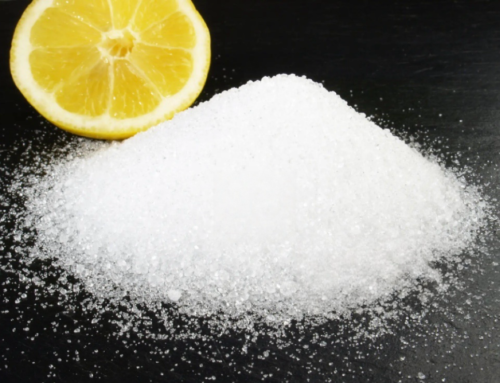 You must have met these two types of additives- magnesium citrate and potassium citrate in certain packing of food. Today, we will dive deeper to learn these two types of additives from their characteristics, differences, and alikeness.
You must have met these two types of additives- magnesium citrate and potassium citrate in certain packing of food. Today, we will dive deeper to learn these two types of additives from their characteristics, differences, and alikeness.
Magnesium Citrate
Characteristics: Magnesium citrate is a compound formed by the combination of citric acid and magnesium ions. It is typically a white crystalline powder with a tangy, citrus-like taste.
Application: In the food industry, magnesium citrate is commonly used as an acidity regulator, buffering agent, and stabilizer. It can adjust the pH of food, and improve its texture and stability. Additionally, magnesium citrate is widely used in pharmaceuticals and dietary supplements as a way to supplement magnesium.
Potassium Citrate
Characteristics: Potassium citrate is a compound formed by the combination of citric acid and potassium ions. It is usually a colorless crystal or white granular substance with a slightly salty taste.
Application: In the food industry, potassium citrate is commonly used as an acidity regulator, thickening agent, and preservative. It can adjust the acidity of food, and enhance its taste and texture. Additionally, potassium citrate is often used in the preparation of electrolyte beverages and rehydration solutions for physical activities.
| Content | Magnesium Citrate | Potassium Citrate |
|---|---|---|
| E-Code | E345 | E332 |
| CAS No. | 7779-25-1 | 866-83-1 |
| HS Code | 29181500 | 29181500 |
| Formula | Mg3(C6H5O7)2 | C6H7O7K |
| Characteristics | White crystalline powder | Colorless crystal or white granular substance |
| Taste | Tangy, citrus-like | Slightly salty |
| Primary Function | Acidity regulation, buffering, stabilizing | Acidity regulation, thickening, preserving |
| Additional Functions | Texture improvement, antioxidant properties | Food preservation, texture stabilization |
| Ion Present | Magnesium ions | Potassium ions |
| Supplement Usage | Common source of magnesium | Common source of potassium |
| Typical Application | Food industry, pharmaceuticals, dietary supplements | Food industry, electrolyte beverages, rehydration solutions |
| Safety Considerations | Generally safe, consult healthcare professional for specific conditions or medications | Generally safe, consult healthcare professional for specific conditions or medications |
What Are Their Differences And Similarities?
Similarities
- Both magnesium citrate and potassium citrate are compounds formed by the combination of citric acid.
- They are both used as acidity regulators in the food industry, capable of adjusting the pH of food.
- Both magnesium citrate and potassium citrate have the ability to stabilize the texture of food.
Differences
- Composition
Magnesium Citrate: Magnesium citrate is a compound composed of magnesium and citric acid. It contains the mineral magnesium in its composition, which provides additional nutritional value when used as a food additive.
Potassium Citrate: Potassium citrate is a compound composed of potassium and citric acid. It contains the mineral potassium, which is a key electrolyte and essential nutrient in the human diet.
- Applications in Food
Magnesium Citrate: Magnesium citrate is commonly used in fortified foods, nutritional supplements, and beverages to provide an additional dietary source of magnesium. It can be found in products such as fortified cereals, energy bars, powdered drink mixes, and mineral water.
Potassium Citrate: Potassium citrate is used in a range of food and beverage applications to increase the potassium content or serve as a pH regulator. It can be found in products like sports drinks, carbonated beverages, fruit juices, and processed foods where potassium fortification is desired.
- Applications in Medicine
Magnesium Citrate: Magnesium citrate is primarily used as a laxative and for bowel preparation. It helps promote bowel movements by drawing water into the intestines, softening the stool, and stimulating muscle contractions in the intestines. It is commonly used to relieve occasional constipation or as part of medical procedures that require emptying the bowel.
Potassium Citrate: Potassium citrate is primarily used to supplement potassium levels in the body and prevent or treat low potassium levels (hypokalemia). It helps maintain proper electrolyte balance, supports normal heart rhythm, and aids in muscle contraction. It is commonly prescribed for individuals with certain medical conditions or those taking medications that may deplete potassium levels.
Can They Be Used Together?
Yes as food additives. Magnesium citrate and potassium citrate can be used together as they complement each other in terms of flavor enhancement and acidity regulation. By combining them in certain foods or beverages, you can achieve a more balanced acidity, improved taste, and enhanced stability.
Consult the doctor first as medicine. The simultaneous use of magnesium citrate and potassium citrate should be done with caution and under the guidance of a healthcare professional. Both compounds can have potential interactions with medications and may affect electrolyte balance in the body. Therefore, it is important to consult a healthcare provider to determine the appropriate dosage and assess the safety of using them together.
Are They Safe?
When used in appropriate amounts, magnesium citrate, and potassium citrate are generally considered safe. However, for certain individuals with specific medical conditions or those taking certain medications, it is advisable to consult a healthcare professional before use to ensure safety and avoid potential interactions or adverse reactions.
In conclusion, magnesium citrate and potassium citrate are commonly used food additives with distinct characteristics and functions. They both serve as acidity regulators, enhancing the taste and stability of food products. Magnesium citrate provides a dietary source of magnesium, while potassium citrate serves as a source of potassium. They can be used together to achieve balanced acidity and improved flavor in food and beverages. When used appropriately, both magnesium citrate and potassium citrate are generally considered safe as food additives. Overall, these additives play a valuable role in the food industry, contributing to nutritional fortification and flavor enhancement while ensuring safety and compliance with regulatory guidelines.




